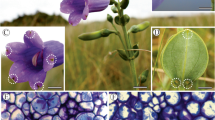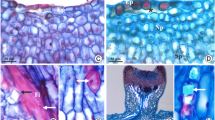Summary
The extrafloral nectary ofAcacia terminalis is of the flat type and is located on the adaxial surface of the petiole of the bipinnate leaf. The secretory area is restricted to the base of the trough and no gaps or pores were detected by staining with vital dyes. Between the vascular bundles beneath the nectary and the surface cuticle there were three cell types. The cells of the flanking zone adjacent to the vascular bundles did not appear to be producing secretion whereas the cells of the glandular and secretory zones were secreting. The cells of the glandular zone were elongated whereas those of the surface secretory zone were spherical. Both had endoplasmic reticulum and Golgi bodies with secretory vesicles which were observed in close association with the plasmalemma. Secretion accumulated in the intercellular spaces of the glandular zone cells and forced the cells of the secretory zone apart. Symplastic contact was maintained in all cell types by plasmodesmata which were often associated with endoplasmic reticulum. Secretion accumulated beneath the cuticle which was distended but remained intact on the surface of the secretion.
Similar content being viewed by others
References
Barthlott, W., Wollenweber, E., 1981: Zur Feinstruktur, Chemie und taxonomischen Signifikanz epicuticularer Wachse und Ähnlicher Sekrete, 67 p. (Tropische und subtropische Pflanzenwelt, 32.) Akademie der Wissenschaften und der Literatur: Mainz. Wiesbaden: Steiner.
Bernhardt, P., Knox, R. B., 1983: The stigmatic papillae ofAmyema (Loranthaceae): Developmental responses to protandry and surface adaptions for bird pollination. Amer. J. Bot.70, 1313–1319.
Boughton, V. H., 1981: Extrafloral nectaries of some Australian phyllodineous acacias. Aust. J. Bot.29, 653–664.
Bronner, R., 1975: Simultaneous demonstration of lipids and starch in plant tissues. Stain Technol.50, 1–4.
Durkee, L. T., 1983: Ultrastructure of nectaries. In: The biology of nectaries (Bentley, B., Elias, T., eds.), pp. 3–29. New York: Columbia University Press.
Fahn, A., Benouaiche, P., 1979: Ultrastructure, development and secretion in the nectary of banana flowers. Ann. Bot.44, 85–93.
Fisher, D. B., 1968: Protein staining of ribboned epon sections for light microscopy. Histochemie16, 92–96.
Frey-Wyssling, A., 1955: The phloem supply to the nectaries. Acta Bot. Neerl.4, 358–369.
Heslop-Harrison, Y., 1977: The pollen-stigma interaction: pollen tube penetration inCrocus. Ann. Bot.41, 913–922.
Joel, D. M., Juniper, B. E., 1982: Cuticular gaps in carnivorous plant glands. In: The plant cuticle (Cutler, D. F., Alvin, K. L., Prices, C. E., eds.), pp. 121–130. London: Academic Press.
—,Rea, P. A., Juniper, B. E., 1983: The cuticle ofDionaea muscipula Ellis (Venus's Flytrap) in relation to stimulation, secretion and absorption. Protoplasma114, 44–51.
Karnovsky, M. J., 1965: A formaldehyde-glutaraldehyde fixative of high osmolarity for use in electron microscopy. J. Cell Biol.27, 137 A.
Kenrick, J., Kaul, V., Knox, R. B., 1984: Self incompatibility and the site of pollen tube arrest in Australian species ofAcacia. Incompatibility Newsletter16, 3–4.
—,Marginson, R., Beresford, G., 1982: Birds and pollination inAcacia terminalis. In: Pollination '82 (Williams, E. G., Knox, R. B., Gilbert, J. H., Bernhardt, P., eds.), pp. 102–109. Proceedings of a Symposium, November 24, 1982, University of Melbourne, Victoria, Australia.
Knox, R. B.,Kenrick, J.,Bernhardt, P.,Marginson, R.,Beresford, G.,Baker, I.,Baker, H. G., 1985: Extrafloral nectaries as adaptations for bird pollination inAcacia terminalis. Amer. J. Bot. (in press).
Mueller, W. C., Greenwood, A. D., 1978: The ultrastructure of phenolic-storing cells fixed with caffeine. J. exp. Bot.29, 757–764.
O'Brien, T. P., McCully, M. E., 1981: The study of plant structure. Principles and selected methods. Melbourne, Australia: Termarcarphi Pty. Ltd.
Rachmilevitz, T., Fahn, A., 1973: Ultrastructure of nectaries ofVinca rosea L.,Vinca major L. andCitrus sinensis Osbeck cv. Valencia and its relation to the mechanism of nectar secretion. Ann. Bot.37, 1–9.
Reynolds, R. S., 1963: The use of lead citrate at high pH as an electron-opaque stain in electronmicroscopy. J. Cell Biol.17, 208–213.
Zimmerman, J. G., 1932: über die extrafloralen Nektarien der Angiospermen. Botanisches Zentralblatt, Beihefte49, 99–196.
Author information
Authors and Affiliations
Rights and permissions
About this article
Cite this article
Marginson, R., Sedgley, M. & Knox, R.B. Structure and histochemistry of the extrafloral nectary ofAcacia terminalis (Salisb.) MacBride (Leguminosae, Mimosoideae). Protoplasma 127, 21–30 (1985). https://doi.org/10.1007/BF01273698
Received:
Accepted:
Issue Date:
DOI: https://doi.org/10.1007/BF01273698




